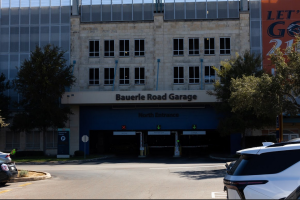This Week in History — Week of April 4
April 4, 2023
April 4, 1975: Bill Gates and Paul Allen founded the Microsoft Corporation.
Childhood friends Gates and Allen founded the Microsoft Corporation in 1975, originally named Micro-Soft for microprocessors and software. Gates dropped out of Harvard University, and Allen quit his programming job to focus on the company, which produced software for the Altair 8800 computer. Allen left the company in 1983 due to health concerns, and Microsoft went public in 1987 and made Gates the world’s youngest billionaire at 31. Microsoft’s Windows operating system was released in 1985 and is the world’s most widely used computer operating system today.
April 5, 1614: Amonute, also known as Pocahontas, married English colonist John Rolfe.
Amonute, private name Matoaka, was the favorite daughter of Wasunsenacah, leader of the Powhatan people that resided in the territory that would become modern-day Virginia. She acted as a bridge between the colonists in Jamestown and her people, brokering an unstable peace between the groups that deteriorated when the colonists started to demand more food from the Powhatan than they could provide. She was taken captive in 1613 by English colonists who ordered that her father provide them with corn and release a number of prisoners, weapons and tools. Although Wasunsenacah released the prisoners, Amonute remained in English custody as he did not return the weapons and tools. She was converted to Christianity, baptized as Rebecca, and married John Rolfe with the consent of her father as a way to restore peace. Rolfe took her to England with their newborn son in 1616, where she was paraded before the king as an “Indian Princess.” She died of an unspecified illness around age 22 in March 1617, just before the Rolfes set sail back to America.
April 6, 1896: The opening ceremony of the first modern Olympic Games was held.
The Olympic games were an ancient Greek tradition held every four years in Olympia, Greece, that celebrated the god Zeus with a number of athletic events, from wrestling to chariot racing. The games were banned by Roman Emperor Theodosius I, a Christian, in 393 C.E. to eradicate paganism. Over 1500 years later, King Georgius I of Greece welcomed athletes from 13 nations to Athens to celebrate the tradition once again. Since then, the Olympic games have been held every four years, excepting the cancellations of the Berlin Olympics in 1916, the Tokyo Olympics of 1940 and the London Olympics of 1944 — all due to war.
April 7, 1947: American entrepreneur Henry Ford died aged 83.
Ford was born on July 30, 1863, and died on April 7, 1947. He was an American industrialist that invented the assembly line and revolutionized the production and distribution of products. Ford Motor Company was founded in 1903 by Ford and 11 associate investors. The company was reincorporated in 1919 to make Ford, his heirs, and the Ford Foundation the sole stockholders of the company, which remained as such until 1956. The first Ford car, the original Model A, was assembled at a Mark Avenue plant in July 1903. The Model T was introduced in 1908, and it was so successful that Ford had to develop methods of mass production to supply. Today, the Ford Motor Company’s headquarters are in Dearborn, Michigan.
April 8, 1973: Spanish artist Pablo Ruiz Picasso died aged 91.
Picasso was born in Malaga, Spain, on October 25, 1881, to Jose Ruiz Blasco, a professor of drawing, and Maria Picasso Lopez. He developed a talent for art from a very young age, creating his first professional painting at 13, and studied under his father’s tutelage. As he grew up, he rejected art-school training and sought to explore his skills elsewhere. Inspired by his artist peers, he set off to Paris in 1900 after his painting “Last Moments” was accepted to be displayed at the Exposition Universelle that year and permanently moved to the city in 1904. From 1909 to 1912, he worked alongside Georges Braque to develop Cubism, an avant-garde style of art that warped reality in abstract ways. One of his most famous pieces is “Guernica,” painted in 1937, which was inspired by the Spanish Civil war. He died in Mougins, France, after dedicating nearly 80 years of his life to art.
April 9, 1865: Robert E. Lee surrendered to Ulysses S. Grant, ending the American Civil War.
The American Civil War between the northern and southern states stemmed from the question of states’ rights under a federal government, namely states’ rights to maintain the institution of slavery. Lee surrendered his troops in Appomattox, Virginia, after being forced to abandon the Confederate capital of Richmond, being prevented from reaching other troops and facing a shortage of food and supplies. Per the terms of the surrender, Lee and his men were pardoned and allowed to return home. The civil war ended with the dissolution of the Confederate States and the beginning of Reconstruction, in which seceded states were reintegrated into the Union on the condition that they ratify the 13th Amendment, which abolished slavery in the United States.
April 10, 1912: The RMS Titanic set sail for its first and only voyage.
Perhaps the most famous shipwreck in popular culture, the White Star Line’s RMS Titanic was, at its time of launch, the largest and most luxurious passenger ship ever made. The ship set sail from Southampton on its way to New York with 2240 passengers and crew on board, and while en route, it struck an iceberg on April 15, four days into its maiden voyage. It took less than three hours to sink, breaking into two pieces in the process. Around 1500 lives were lost in the disaster, with the crew and Third Class passengers suffering the most casualties. The sinking of the Titanic led to improvements in maritime navigation and strict safety regulations. The wreck of the Titanic was located in 1985, and while some parts have been recovered, the majority of the ship remains at the bottom of the Atlantic Ocean.
April 11, 1970: Apollo 13 was launched.
After the successes of the Apollo 11 and the Apollo 12 missions, Apollo 13 was set to be NASA’s third moon-landing mission. The mission was manned by astronauts John “Jack” Swigert as command module pilot, Fred Haise as lunar module pilot and James Lovell as the commander. Almost 56 hours into the mission, oxygen tank No. 2 blew up, causing No. 1 to fail and lose two out of three fuel cells. It was at this time that Swigert said, “Houston, we’ve had a problem here,” echoed right after by Lovell. At around 200,000 miles from Earth, the Apollo 13 crew lost their main supply of electricity, light and water. One oxygen tank was completely empty, and the other one was venting rapidly. The crew was instructed to move into the Aquarius lunar module as NASA personnel back on Earth searched for a way to get them back safely. Apollo 13 changed course to slingshot around the moon and used the module’s engine to speed them back to Earth while they worked to repair the Odyssey command module. They splashed down in the Pacific Ocean in the repaired Odyssey on April 17. The mission was considered a “successful failure” in that it failed its original purpose, but the crew returned safely against all odds due to ingenuity and sheer effort.







